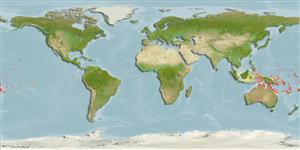>
Gobiiformes (Gobies) >
Gobiidae (Gobies) > Gobiinae
Etymology: Eviota: No etymology given, suggested by Christopher Scharpt: from Latin 'eu' for 'true' and 'iota' for anything very small, in combination 'truly very small' referring to it as being the smallest vertebrate at the time it has benn described by Jenkins (thus, making the suggestion by Scharpt plausible.; cometa: Name from Latin word for comet, referring to the basicaudal spot and the trailing dark streak (Ref. 5291).
More on authors: Jewett & Lachner.
Environment: milieu / climate zone / depth range / distribution range
Ökologie
seewasser riff-verbunden; tiefenbereich 1 - 30 m (Ref. 127576). Tropical; 7°N - 24°S
Southwestern Pacific: Fiji and Tonga.
Size / Gewicht / Alter
Maturity: Lm ? range ? - ? cm
Max length : 1.6 cm SL Männchen/unbestimmt; (Ref. 127576)
Kurzbeschreibung
Bestimmungsschlüssel | Morphologie | Morphometrie
Rückenflossenstacheln (insgesamt) : 7; Rückenflossenweichstrahlen (insgesamt) : 9; Afterflossenstacheln: 1; Afterflossenweichstrahlen: 8. This species is distinguished from its congeners by the following characters: a cephalic sensory-canal pore pattern lacking only IT pore (pattern 2), AITO pore small and opening dorsally; a dorsal/anal fin-ray formula of 9/8; unbranched pectoral-fin rays 16 or 17 (usually 17); fifth pelvic-fin ray 5-17% of fourth ray; body depth 18-23% SL. Colouration: pectoral-fin base without dark occipital spots or dark spots; entire iris of eye is dark reddish, pupil surrounded by a white ring, dorsal side of eye next to interorbital area has a short white bar not visible laterally; a two-part, black, basicaudal spot over preural centrum made up of a short, wedge-like, triangular front section connecting to a short, wide bar over end of hypural plate, and with a yellow spot over nexus; caudal fin is crossed by thin, red, diagonal bars, pale when preserved (Ref. 127576).
Collected from consolidated coral growth rising 2 m off sand and silt bottom, in 9-15 m depth; also from turbid waters on fine-sand and coral-rubble bottom (Ref. 127576).
Life cycle and mating behavior
Maturities | Fortpflanzung | Spawnings | Egg(s) | Fecundities | Larven
Tornabene, L., D.W. Greenfield and M.V. Erdmann, 2021. A review of the Eviota zebrina complex, with descriptions of four new species (Teleostei, Gobiidae). ZooKeys 1057:149-184. (Ref. 126577)
IUCN Rote Liste Status (Ref. 130435)
Bedrohung für Menschen
Harmless
Nutzung durch Menschen
Tools
Zusatzinformationen
Download XML
Internet Quellen
Estimates based on models
Phylogenetic diversity index (Ref.
82804): PD
50 = 0.5000 [Uniqueness, from 0.5 = low to 2.0 = high].
Bayesian length-weight: a=0.01023 (0.00477 - 0.02194), b=3.02 (2.84 - 3.20), in cm total length, based on LWR estimates for this (Sub)family-body shape (Ref.
93245).
Trophic level (Ref.
69278): 3.0 ±0.3 se; based on size and trophs of closest relatives
Widerstandsfähigkeit (Ref.
120179): hoch, Verdopplung der Population dauert weniger als 15 Monate. (Preliminary K or Fecundity.).
Fishing Vulnerability (Ref.
59153): Low vulnerability (10 of 100).
Nutrients (Ref.
124155): Calcium = 363 [161, 1,088] mg/100g; Iron = 1.64 [0.74, 3.48] mg/100g; Protein = 18.1 [16.0, 19.9] %; Omega3 = 0.166 [0.057, 0.455] g/100g; Selenium = 27.9 [9.5, 71.8] μg/100g; VitaminA = 127 [29, 575] μg/100g; Zinc = 4.22 [2.38, 6.86] mg/100g (wet weight);
